
Plains coreopsis, garden tickseed, golden tickseed, or calliopsis, Coreopsis tinctoria, is an annual forb. The plant is common in Canada, northeast Mexico, and much of the United States, especially the Great Plains and Southern states where it is often called "calliopsis." The species is also widely cultivated and naturalized in China.
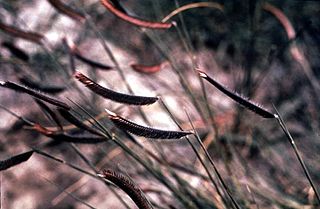
Bouteloua gracilis, the blue grama, is a long-lived, warm-season (C4) perennial grass, native to North America.
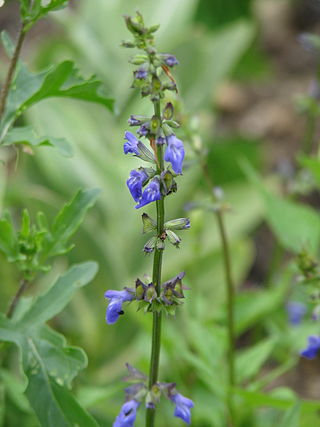
Salvia arizonica is a species of sage known commonly as desert indigo sage and Arizona sage. It can be distinguished from its relatives by its triangular, serrated leaves. It blooms copiously in small blue flowers. This is a vigorous sage which propagates via underground spreading runners and seeds. It is native to Arizona, New Mexico, and Texas. It is frequently found at higher elevations.

Ratibida columnifera, commonly known as upright prairie coneflower, Mexican hat, and longhead prairie coneflower, is a perennial species of flowering plant in the genus Ratibida in the family Asteraceae. It is native to much of North America and inhabits prairies, plains, roadsides, and disturbed areas from southern Canada through most of the United States to northern Mexico.

Iris missouriensis is a hardy flowering rhizomatous species of the genus Iris, in the family Iridaceae. Its common names include western blue flag, Rocky Mountain iris, and Missouri flag.
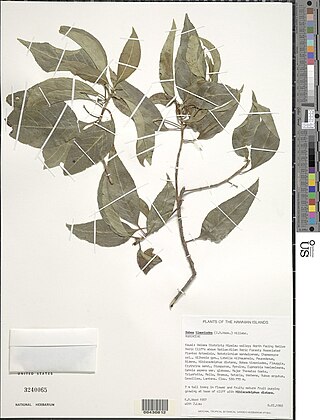
ʻAhakea is a species of flowering tree in the coffee family, Rubiaceae, that is endemic to Hawaiʻi. It inhabits dry, coastal mesic and mixed mesic forests at elevations of 250–580 metres (820–1,900 ft) on the islands of Hawaiʻi and Maui. It is threatened by habitat loss.

Eurya sandwicensis, the ānini or wānini, is a species of flowering plant in the family Pentaphylacaceae, that is endemic to Hawaiʻi. It is threatened by habitat loss.
Melicope paniculata, the Lihue melicope, is a rare species of tree in the family Rutaceae. It is endemic to the Hawaiian Islands. Like other Hawaiian Melicope, this species is known as alani.

Baccharis salicifolia is a blooming shrub native to the sage scrub community and desert southwest of the United States and northern Mexico, as well as parts of South America. Its usual common name is mule fat; it is also called seepwillow or water-wally. This is a large bush with sticky foliage which bears plentiful small, fuzzy, pink or red-tinged white flowers which are highly attractive to butterflies. The long pointed leaves may be toothed and contain three lengthwise veins. It is most common near water sources.
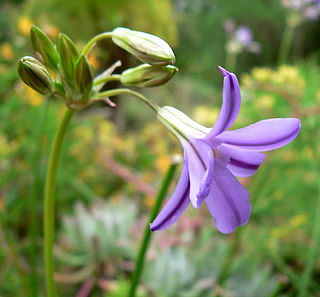
Brodiaea kinkiensis is a species of Brodiaea also with the common name San Clemente Island brodiaea. This flower is endemic to San Clemente Island, one of the Channel Islands of California.
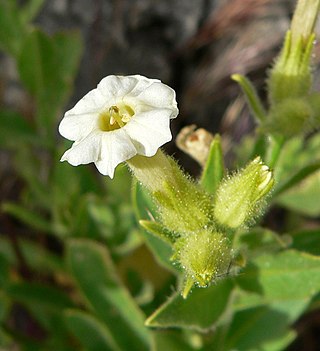
Nicotiana obtusifolia, or desert tobacco, is a plant native to the southwestern United States and Mexico.

Chaetopappa ericoides is a species of flowering plant in the family Asteraceae known by the common names rose heath and heath-leaved chaetopappa. It is native to the southwestern and western Great Plains regions of the United States, plus northern Mexico. It is found in California, Nevada, Arizona, Utah, New Mexico, Colorado, Wyoming, Texas, Oklahoma, Kansas, Nebraska, Chihuahua, Coahuila, Sonora, Durango, Zacatecas, San Luis Potosí, and Nuevo León.

Agrostis hallii is a species of grass known by the common names Hall's bentgrass, Hall Redtop, and Hall's Bent Grass.
Eriogonum jamesii is a species of wild buckwheat known by the common name James' buckwheat and antelope sage. It is native to the southwestern United States, being found in: Colorado, Utah, Arizona, Texas, New Mexico, Oklahoma, and Nebraska.
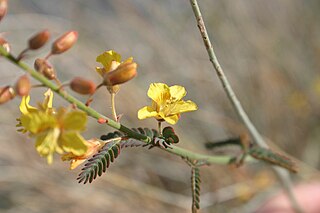
Hoffmannseggia microphylla is a species of flowering plant in the legume family known by the common name wand holdback. It is native to the southwestern United States and Baja California and grows in gullies, canyons, slopes and primarily creosote bush scrub.

Mitella ovalis is a species of flowering plant in the saxifrage family known by the common names coastal miterwort and oval-leaf miterwort. It is native to western North America from southwestern British Columbia, including Vancouver Island, to northern California as far south as Marin County. It grows in moist, shady habitat, such as coastal forests and streambanks.
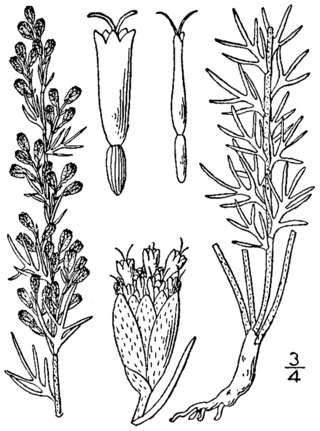
Artemisia carruthii, common name Carruth's sagewort or Carruth wormwood, is a North American species of shrubs in the daisy family native to much of south-central and southwestern United States. There are reports of a few naturalized populations in Missouri, the Great Lakes Region, and Rhode Island. It is also native to the States of Chihuahua and Sonora in northern Mexico.
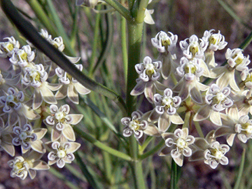
Asclepias subverticillata is a plant found in the southwestern United States and Mexico. Common names include horsetail milkweed, poison milkweed and whorled milkweed.

Astragalus amphioxys, common name crescent milkvetch, is a plant found in the American southwest, including the whole of Utah, the southeast part of Nevada, the north part of Arizona, the western part of Colorado, the northwestern part of New Mexico, and one county in Texas. It was first described by Asa Gray in 1878.

Castilleja integra, with the common name wholeleaf paintbrush, is an partially parasitic herbaceous perennial plant native to the Southwestern United States.

















